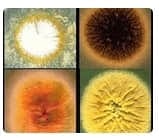Exam Details
Exam Code
:ASCP-MLTExam Name
:MEDICAL LABORATORY TECHNICIAN - MLT(ASCP)Certification
:ASCP CertificationsVendor
:ASCPTotal Questions
:572 Q&AsLast Updated
:Mar 29, 2025
ASCP ASCP Certifications ASCP-MLT Questions & Answers
-
Question 541:
Hepatitis B surface antigen, or HBs, is a protein that is present on the surface of the virus. The protein will be present via laboratory testing in the blood with acute and chronic HBV infections Immunology What sero-marker is the first marker to become positive in Hepatitis B and is associated with the infective stage?
A. HBc antibody
B. HBc total
C. HBs antigen
D. Hbs antibody
E. Hbe antigen
-
Question 542:
Ferritin and hemosiderin are considered storage forms of iron. Which substance(s) is/are considered iron storage compounds?
A. hemosiderin
B. ferritin
C. hemoglobin
D. myoglobin
-
Question 543:
Micro - Matching
1.
Upper left image Multi-celled, rough walled macroconidia with a tapered terminal cell
2.
Upper right image Dense aggregates of echinulate, brown-black conidia
3.
Lower left image Loose clusters of elliptical conidia arranged in a "diphtheroid" pattern
4.
Lower right image Chains of large, lemon-shaped annelloconidia

A. Aspergillus niger
B. Microsporum canis
C. Scopulariopsis species
D. Acremonium species
-
Question 544:
Which of the following legislation was developed to protect the privacy of all patient information in the health care?
A. Health Insurance Portability and Accountability Act (HIPPA)
B. Occupational Safety and Health Administration (OSHA)
C. Clinical Laboratory Standards Institute (CLSI)
D. Clinical Laboratory Improvement Amendments (CLIA)
-
Question 545:
What has happened in a titer, if tubes #5-7 show a stronger reaction than tubes #1-4?
A. poor technique
B. postzone reaction
C. prozone reaction
D. equivalence reaction technical error
-
Question 546:
The results of this PT and aPTT are in normal range. These results can be reported and are not indicative of the need to: order a mixing study or request a redraw.
You have just performed stat PT and aPTT tests on your coagulation instrument. Your results are as follows:
PT = 12 seconds (normal range 10-13 seconds)
aPTT = 24 seconds (normal range 21-34 seconds)
What would be your next step?
A. Perform a mixing study
B. Report the results
C. Request a redraw of the specimen
-
Question 547:
The role of the laboratory supervisor or manager is to
A. Supervise business functions of testing.
B. Screen cytology for Pap smears.
C. Examine surgically removed organ
D. Supervise technical aspects of testing.
-
Question 548:
Hemolytic transfusion reactions seldom occur because the incidence of unexpected antibodies in random patients is relatively low, e.g., 3-5% is sometimes cited.
Being transfused with O Rh negative RBC is irrelvant if you have an unexpected antibody like anti-K or anti-c.
Incompatible red cells may "bleed out" but only if bleeding is brisk. Even then, a hemolytic reaction may occur later once the patient's antibody rebounds and destroys remaining antigen-positive donor red cells.
It's true that some patients have only cold-reactive antibodies that will not react at body temperature. But this does not explain why warm-reactive red cell antibodies cause few reactions
Why do so few patients transfused with un-crossmatched red cells in an emergency experience a hemolytic transfusion reaction? Select the one best reason.
A. The incidence of unexpected red cell antibodies is relatively low.
B. They usually receive group O Rh negative red cells; a hemolytic transfusion reaction will never occur if O Rh-negative red cells are transfused.
C. They hemorrhage so severely that incompatible donor red cells "bleed out" before a reaction occurs.
D. Some patients have cold-reactive antibodies that will not react at body temperature.
-
Question 549:
G6PD deficiency causes an increased suseptibility to the oxidation of hemoglobin, which in turn, causes the precipitation of hemoglobin inside of the red blood cell. Which one of the following conditions is associated with glucose-6-phosphate dehydrogenase (G6PD) deficiency?
A. Microcytic red cells
B. Precipitation of hemoglobin
C. Faulty heme synthesis
D. Hemoglobins with low oxygen affinities
-
Question 550:
White top tubes are used for blood cultures. Question options:
A. True
B. False
Related Exams:
Tips on How to Prepare for the Exams
Nowadays, the certification exams become more and more important and required by more and more enterprises when applying for a job. But how to prepare for the exam effectively? How to prepare for the exam in a short time with less efforts? How to get a ideal result and how to find the most reliable resources? Here on Vcedump.com, you will find all the answers. Vcedump.com provide not only ASCP exam questions, answers and explanations but also complete assistance on your exam preparation and certification application. If you are confused on your ASCP-MLT exam preparations and ASCP certification application, do not hesitate to visit our Vcedump.com to find your solutions here.